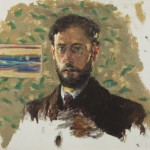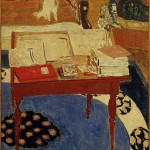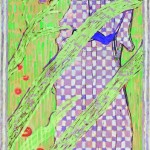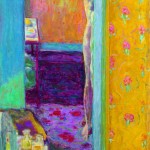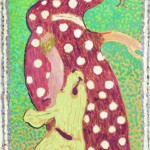Subscribe to Our Newsletter
Pierre Bonnard: Trouble in Paradise
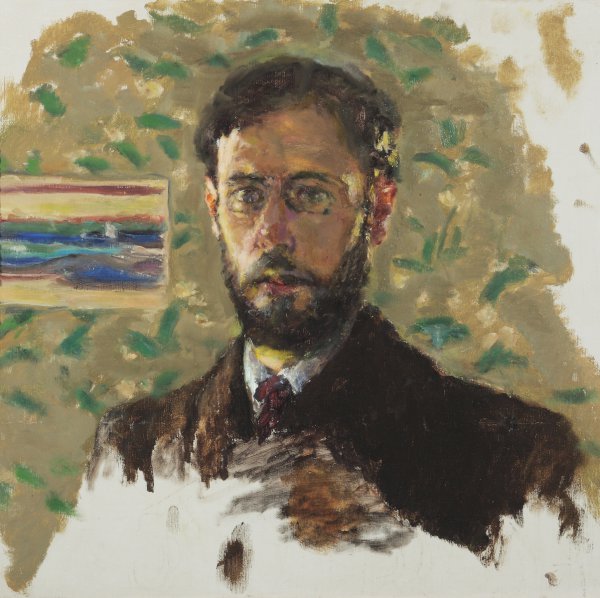
Pierre Bonnard’s search for Arcadian bliss may have been frustrated in life, but it yielded a harvest of color that endures in art.
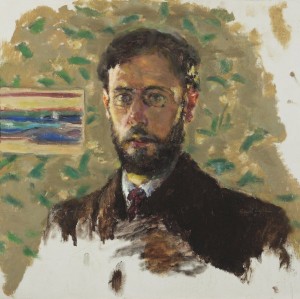
Pierre Bonnard, Self-Portrait, c. 1904, oil on canvas, 18.125 x 18.75;
Featured Images: (Click to Enlarge)
- Pierre Bonnard, Self-Portrait, c. 1904, oil on canvas, 18.125 x 18.75;
- Pierre Bonnard, The Work Table, 1926-37, oil on canvas, 121.9 x 91.4 cm;
- Pierre Bonnard, Women in the Garden, 1890-1891, distemper on paper mounted on canvas, 160.5 x 48 cm.;
- Pierre Bonnard, Nude in an Interior, 1935, oil on canvas, 134 x 69.2;
- Pierre Bonnard, Women in the Garden: Woman in Dress with White Dots, 1890-1891, distemper on paper mounted on canvas, 160.5 x 48 cm.;
“Beauty is truth, truth beauty,” John Keats wrote in Ode on a Grecian Urn (1819). In the 20th century, however, the philosophical marriage of truth and beauty came apart. Eternal Neoclassical ideals became stage props for political theater, and the intuitions of Romantic optimism dissolved in an empty cosmos. Modernism, born in the 19th century and buried in the 20th, described this disenchantment. In an age of hard truths, ugliness seemed next to honesty, and a manifesto better than no hope at all. And where did that leave Pierre Bonnard (1867–1947), an idiosyncratic colorist in an age of terrible simplifications, a private, modest man in an age of public art and self-publicizing artists?
“Painting Arcadia,” at the Fine Art Museums of San Francisco from February 6–May 15, is the first major international presentation of Bonnard’s work to be mounted on the West Coast in half a century. (The exhibition, which originated at the Musée d’Orsay, Paris, will also be mounted from September 11 at the MAPFRE Foundation in Madrid.) Featuring more than 60 works from every phase of the artist’s long career, the show demonstrates why Bonnard seemed out of step among his cohort, even as he looked south to the mythical Mediterranean like Matisse and Picasso. It also suggests how, as Fairfield Porter recognized, Bonnard opened for representational art a different, and still underexplored, pathway between Impressionism and Abstraction.
It was Bonnard’s misfortune to be born into a respectable family—his father was a senior civil servant—and to have enjoyed an unremarkably happy childhood in an affluent suburb of Paris. Trained as a lawyer, he practiced as one briefly, and then, defying the canons of artistic biography, became a professional painter without offending his parents. In his 20s, he had the temerity to produce decorative work in various media: dreamy drawings, posters, and book illustrations bearing the influence of Odilon Redon, Art Nouveau, and Japanese prints. Then, in a momentary aberration, Bonnard joined his friends Paul Ranson and Édouard Vuillard in an avant-garde movement.
The Nabis—the name meant “prophets” in Hebrew—were in the tradition of the Nazarenes, Ancients, and Pre-Raphaelites: an extended group of friends, bound as much by youth and ambition as by common aesthetic goals. And just as Ruskin’s defense of the Pre-Raphaelites made better reading than Dante Gabriel Rossetti’s verse, so the most memorable Nabi statement came from a journalist, Maurice Denis, who described a painting as “a flat surface covered with colors assembled in a certain order.”
The flatness was Japanese by inspiration, the ordering of the colors Impressionist, and the purpose spiritual in the post-Symbolist manner, with aspirations toward the energetic clarity of primitivism; Henri Bergson’s vitalism was the philosophy of the day. From the contemporary ukiyo-e prints that Bonnard bought in large quantities from Parisian department stores, he learned how to depict “light, form, and character using nothing but color.” This was a constructive misunderstanding: although Bonnard’s Nabi nickname was le Nabi très japonard, he did not know that his Japanese contemporaries achieved these effects by using imported European aniline pigments, rather than traditional plant-based paints.
Maurice Denis described the young Bonnard as an Edo-style “artist of the floating world,” but Bonnard’s 1890s paintings are also the aperçus of a Baudelairean “artist of the modern world,” a flâneur gathering erotic impressions and opiated images on the seamy side of the boulevard. In The Two Carriages (1901), the illusionary merging of two moving vehicles both anatomizes a moment of violence and suspends its consequences. In the foreground of Walking at the Lake (circa 1900), two women walk in opposite directions along a path. The tension between them seems to pull the composition in half. Behind them, a declivity in the park gives the impression of other walkers, all apparently female, being cut off at the waist.
In Dancers (1896), another all-female image, the corps de ballet hold fixed postures that are technically natural but physically painful; the women float on a gray stage, its surface mottled like the pond at Giverny. In The Omnibus (1895), a woman, fashionably dressed with a cinched waist and a lapdog on a leash, is poised before the bus’s bright yellow wheel, itself momentarily halted. The foreshortening of the artist’s flattened world and the raising of her leash hand give her the appearance of a sinner attached to some Dantean device or the wheel of death in a circus.
Bonnard’s capture of unique and impossible moments recalls Eadweard Muybridge’s photographs of the horse that might pull the omnibus and the way photography intensified the ancient challenge of depicting movement in stillness. But the implications of suffering and isolation in these pictures evoke another horse from modernist mythology, in another street scene from the 1890s: the carthorse in Nietzsche’s apotheosis at Milan, flogged to death by its furious owner and embraced by the philosopher. In Bonnard’s early compositions, the truth of beauty is psychologically cruel, the violence as much prolonged as deferred; as in the Decadent novelist Octave Mirbeau’s 1899 story Torture Garden, which depicts civilized society as a Nietzschean playpen for sadists and masochists.
Mirbeau cast his dog as the hero of a late novel, Dingo (1913). Bonnard, who reserved expressions of personal emotion for his pets, was already looking for a way out of the urban maze. In Twilight (1892), the restrained, amiable croquet players are hedged in by massing green shrubbery, courtesy of Paul Gauguin’s Tropical Gardening Service. Beyond the shadowed players, a circle of white-clad maidens wheel in a modest dance of tribute to Nature as the sun gently sets. The wheel is both mobile and stable; disturbing forces are, like the horse in The Omnibus, outside the frame—or on their way out. In the Normandy pastoral of The Large Garden (1895), a small girl runs away from her apple-picking younger siblings. She is already halfway out of the image: her face has left the canvas, and her body is blurred in motion: she is a presence, not a personality. The alert posture of the family dog—its face rendered in profile—hints at unseen and un-shown dangers.
In the early 1900s, Bonnard expunged the modern world from his paintings—even cars, which he liked. After a few slow years during which he seems to have confronted his Impressionist masters by imitation, in 1910 he left the gloomy north for Keats’ “warm south.” The Côte d’Azur was the Arcadia of modern painting, where searing light met scenic peasant life, and the amenities of bourgeois civilisation the ruins of its Greco-Roman precursor. One of the decorative panels that preceded Bonnard’s departure—Water Games, or The Voyage (1906–10) is a dreamlike decorative journey into the past, the moving figures as solid as marble.
“Nature,” Schopenhauer wrote, “covers all her works with a varnish of beauty.” The massive triptych The Mediterranean (1911) was commissioned by the collector Ivan Morozov. Shaded by olive and oak trees, Bonnard’s nephews and nieces play in the sun, while his lifelong model Martha de Méligny sits in the shade with a cat. The shadows are purple like grapes, the sunlit gently pinkish. Through the trees, red-tiled roofs zigzag discreetly down to a mild blue sea. Painted as a single composition, The Mediterranean was divided to fit around the Ionic columns of the staircase landing in Morozov’s Moscow townhouse: modern douceur de vie in a Neoclassical frame.
Yet, as the art historian Erwin Panofsky showed, the modern vision of Arcadia was not that of Virgil and the Renaissance pastoral, in which the fullness of Nature includes the tragic. In Poussin’s The Arcadian Shepherds (1637–38), the memento mori skull is outside the frame. This encouraged a creative misreading of the tag on the tomb: Et in Arcadia ego became the last testimony of the tomb’s inhabitant—“I, too, was in Arcadia”—instead of the original and grammatically accurate reminder of death’s unlimited jurisdiction, “Even in Arcadia, I am here.” The erroneous reading, Panofsky wrote, suggests that the Arcadians “are not so much warned of an implacable future as they are immersed in a mellow meditation of a beautiful past.” The accurate reading warns of the transience of beauty and personality. “Even in Arcadia,” wrote Panofsky, “there existed the two fundamental tragedies of human life, inextricably connected with one another: frustrated love and death.”
If Bonnard went back to the garden seeking Gauguin’s fiction of innocent beauty, he found Arcadia’s cruel truth. The biography has the terrible clarity of myth. Bonnard’s companion, the model Marthe de Méligny, was a depressive, a joyless analogue to Baudelaire’s muse, Jeanne Duval. In 1918, Bonnard fell in love with her much younger friend, the artist Renée Monchaty; she, not Marthe, is the model in Naked Girl by the Fireplace (1919) and also appears to be the recumbent nude who completes The Earthly Paradise (1916–20). If Bonnard proposed marriage, he lost his nerve; few self-portraits are as self-mocking as the spindly coward in The Boxer (1931). In 1925, Bonnard married Marthe. One month later, Renée committed suicide. Like an Intimiste Ophelia, she shot herself on a hotel bed strewn with flower petals.
“Poor Marthe has become completely misanthropic,” Bonnard confided to Berthe Signac in 1932. “She no longer wants to see anyone, not even her old friends, and we are condemned to absolute solitude.” In Paris, Bonnard had depicted the seamy Intimisme of rented rooms and troubled sleepers. As Marthe became an invalid, the artist with a plein air palette was entombed in the impersonal intimacy of spa rooms and rented villas near hot springs—grotesque parodies of pagan shrines and temples. Bonnard worked from written notes and memory, carefully building his spontaneous instants. His interiors are prone to phantasmal effects, tricks of Arcadian light, and excess effulgences of color. Alfred Jarry, for whose 1898 play Ubu Roi Bonnard created figurines, described the grotesque as “that other form of the beautiful.”
“The passion excited by beauty,” wrote Edmund Burke in The Sublime and the Beautiful (1756), “is nearer to a species of melancholy than to jollity or mirth.” Bonnard’s endless and tender nudes of Marthe are invariably beautiful and invariably melancholic. Her face is often turned away; she never looks him in the eye. “Solitude,” reflects the protagonist of Mirbeau’s Diary of a Chambermaid (1900), “does not consist of living alone; it consists in living with others, with people who take no interest in you.” If Bonnard, unlike Picasso, respects his subject’s distance, he also blurs her into the water of her baths and the wallpaper of their home. In Nude in the Bath (1936–38), Marthe is depersonalized and cut in half, with only her legs visible. “For me,” Mirbeau’s chambermaid says, “all crime, especially murder, has secret ties with love.”
In Lawrence Alma-Tadema’s sickly masterpiece, The Roses of Heliogabalus (1888), the decadent emperor delights and then stifles the guests at his banquet by having rose petals tipped onto them in such quantities that some of them asphyxiate. In Bonnard’s The Abduction of Europa (1919), the decorative surface almost masks the sexuality and violence of the mythic narrative: the endless sea, not the tragedy on the shore, is the story.
“To name an object,” Mallarmé wrote in 1891, “is to suppress three-quarters of the enjoyment of the poem, which is made to be divined bit by bit: to suggest it, that is the dream.” Like Peer Gynt, transported in multiple dreams of his life, Bonnard escaped into fiction, fleeing sorrow and restriction for boundless lyricism. He was not a Nabi without honor in his own country: he was modern enough, and more than French enough. But he was not entirely respected. Picasso mocked him as quaint and twee. When the historian Christian Zervos dismissed him as “insipid,” a spectacle of Impressionism in decline, Matisse corrected Zervos: “Bonnard is a great artist for our time and for posterity.” Bonnard himself admitted feeling “outpaced” by the “evolution” of early 20th-century art. “Society welcomed Cubism and Surrealism before we could reach what we had considered our goal… It was as if were left suspended in space.”
Jean Clair, curator of the 1984 exhibition at the Centre Georges-Pompidou that greatly aided the revival of Bonnard’s critical standing, said that perception itself is Bonnard’s true subject—color suspended in space and time. Bonnard’s infinitude of color, the proof of beauty, adorns and blurs the deeper resonances of an Arcadian memento mori. Keats said that the dream of Arcadia may “tease us out of thought / As doth eternity: Cold pastoral!” Bonnard, asked about the relationship of truth and beauty, gave an Arcadian reply: “Many small lies yield a great truth.”
—
By Dominic Green

